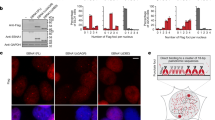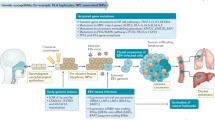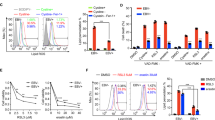Abstract
Since the few data exploring a possible association between Epstein–Barr virus (EBV) and breast cancer are conflicting, we investigated this association together with the influences of geographical areas. 509 breast cancers were sampled from areas with varying risks of nasopharynx carcinoma (NPC) such as North Africa (Algeria and Tunisia, high-risk area); southern France (Marseille, intermediate-risk area); and northern Europe (northern France, the Netherlands and Denmark; low-risk areas). Polymerase chain reaction (PCR) of a subregion of EBV BamHIC encoding the EBERs demonstrated that 31.8% of the tumours contained the viral genome. No significant differences were observed among the geographical areas. However, positive samples showed higher loads of the EBV genome in the NPC high- and intermediate-risk areas than in the low-risk areas. EBV type 1 was the dominant strain. In situ hybridization studies using a35S-labelled riboprobe for EBER1 and a laser capture microdissection, combined with quantitative PCR, showed that EBV localization was restricted to some tumour epithelial cell clusters. EBV could not be detected in the stroma. Considering the whole population covered, the presence of the EBV genome was not correlated with age, menopausal status, tumour, size, nodal status or histological grade. © 2001 Cancer Research Campaign
Similar content being viewed by others
Article PDF
Change history
16 November 2011
This paper was modified 12 months after initial publication to switch to Creative Commons licence terms, as noted at publication
References
Andersen KW, Mouridsen HT, Castberg T, Fischerman K, Andersen J, Hou-Jensen K, Brincker H, Johansen H, Henriksen E, Rorth M and Rossing N (1981) Organisation of the Danish adjuvant trials in breast cancer. Dan Med Bull 28: 102–106
Bonnet M, Guinebretiere JM, Grunewald V, Kremmer E, Grunewald V, Benhamou E, Contesso G and Joab I (1999) Detection of Epstein–Barr virus in invasive breast cancers. J Natl Cancer Inst 91: 1376–1381
Bouchardy C, Parkin DM, Wanner P and Khlat M (1996) Cancer mortality among north African migrants in France. Int J Epidemiol 25: 5–13
Brink AA, Van den Brule AJ, Van Diest P and Meijer CJ (2000) Re: detection of Epstein-Barr virus in invasive breast cancers. J Natl Cancer Inst 92: 655–656
Buisson M, Morand P, Genoulaz O, Bourgeat MJ, Micoud M and Seigneurin JM (1994) Changes in the dominant Epstein–Barr virus type during human immunodeficiency virus infection. J Gen Virol 75: 431–437
Bustin SA (2000) Absolute quantification of mRNA using real-time reverse transcription polymerase chain reaction assays. J Mol Endocrinol 25: 169–193
Chang KL, Chen YY, Shibata D and Weiss LM (1992) Description of an in situ hybridization methodology for detection of Epstein-Barr virus RNA in paraffin-embedded tissues, with a survey of normal and neoplastic tissues. Diagn Mol Pathol 1: 246–255
De Thé G (1993) Epidemiology, pathogenesis and prevention of EBV associated malignancies. In The Epstein–Barr virus and associated diseases. Tursz T, Pagano JS, Ablashi DV, de Thé G, Lenoir G, Pearson GR (eds.), pp. 15–30, Colloque INSERM, Vol 225, John Libbey Eurotext Ltd
Gaffey MJ, Frierson HF Jr, Mills SE, Boyd JC, Zarbo RJ, Simpson JF, Gross JK and Weiss LM (1993) Medullary carcinoma of the breast. Identification of lymphocyte subpopulations and their significance. Mod Pathol 6: 721–728
Glaser SL, Ambinder RF, DiGiuseppe JA, Horn-Ross PL and Hsu JL (1998) Absence of Epstein-Barr virus EBER-1 transcripts in an epidemiologically diverse group of breast cancers. Int J Cancer 75: 555–558
Horiuchi K, Mishima K, Ohsawa M and Aozasa K (1994) Carcinoma of stomach and breast with lymphoid stroma: localisation of Epstein-Barr virus. J Clin Pathol 47: 538–540
Hubert A, Jeannel D, Tuppin P and de Thé G (1993) Anthropology and epidemiology: a pluridisciplinary approach of environmental factors of nasopharyngeal carcinoma. Tursz T, Pagano JS, Ablashi DV, de Thé G, Lenoir G, Pearson GR (eds). The Epstein–Barr virus and associated diseases Colloque INSERM 225, John Libbey Eurotext Ltd
Epstein-Virus and Kaposi’s sarcoma herpesvirus/human herpes virus, (1997). IARC monographs on the evaluation of carcinogenic risks to humans 70, Lyon
Jeannel D, Ghnassia M, Hubert A, Sancho-Garnier H, Eschwege F, Crognier E and de-The G (1993) Increased risk of nasopharyngeal carcinoma among males of French origin born in Maghreb (north Africa). Int J Cancer 54: 536–539
Joab I (2000) Response: re: detection of Epstein-Barr virus in invasive breast cancers. J Natl Cancer Inst 92: 656
Labrecque LG, Barnes DM, Fentiman IS and Griffin BE (1995) Epstein–Barr virus in epithelial cell tumors: a breast cancer study. Cancer Res 55: 39–45
Lespagnard L, Cochaux P, Larsimont D, Degeyter M, Velu T and Heimann R (1995) Absence of Epstein–Barr virus in medullary carcinoma of the breast as demonstrated by immunophenotyping, in situ hybridization and polymerase chain reaction. Am J Clin Pathol 103: 449–452
Ouafik L, May V, Keutmann HT and Eipper BA (1989) Developmental regulation of peptidylglycine alpha-amidating monooxygenase (PAM) in rat heart atrium and ventricle. Tissue- specific changes in distribution of PAM activity, mRNA levels, and protein forms. J Biol Chem 264: 5839–5845
Ouafik L, May V, Saffen DW and Eipper BA (1990) Thyroid hormone regulation of peptidylglycine alpha-amidating monooxygenase expression in anterior pituitary gland. Mol Endocrinol 4: 1497–1505
Parkin DM (1986). Cancer occurrence in developing countries 75, IARC: Lyon
Parkin DM and Iscovich J (1997) Risk of cancer in migrants and their descendants in Israel: II. Carcinomas and germ-cell tumours. Int J Cancer 70: 654–660
Penault-Llorca F, Adelaide J, Houvenaeghel G, Hassoun J, Birnbaum D and Jacquemier J (1994) Optimization of immunohistochemical detection of ERBB2 in human breast cancer: impact of fixation. J Pathol 173: 65–75
Rickinson AB, Young LS and Rowe M (1987) Influence of the Epstein–Barr virus nuclear antigen EBNA 2 on the growth phenotype of virus-transformed B cells. J Virol 61: 1310–1317
Romain S, Martin PM, Klijn JG, van Putten WL, Look MP, Guirou O and Foekens JA (1997) DNA-synthesis enzyme activity: a biological tool useful for predicting anti-metabolic drug sensitivity in breast cancer?. Int J Cancer 74: 156–161
Sambrook J, Fritsch EF and Maniatis T (1989). Molecular cloning: a laboratory manual, Cold Spring Harbor, Cold Spring Harbor Laboratory
Sobin LH and Wittekind Ch (1997). UICC International Union Against Cancer. TNM classification of malignant tumors, Wiley-Liss: New York
Steinitz R, Iscovich JM and Katz L (1990) Cancer Incidence in young offspring of Jewish immigrants to Israel. A methodological study. I. Nasopharyngeal malignancies and Ewing sarcoma. Cancer Detect Prev 14: 547–553
Tabbane F, Muenz L, Jaziri M, Cammoun M, Belhassen S and Mourali N (1977) Clinical and prognostic features of a rapidly progressing breast cancer in Tunisia. Cancer 40: 376–382
Tabbane F, el May A, Hachiche M, Bahi J, Jaziri M, Cammoun M and Mourali N (1985) Breast cancer in women under 30 years of age. Breast Cancer Res Treat 6: 137–144
zur Hausen H (1991) Viruses in human cancers. Science 254: 1167–1173
Author information
Authors and Affiliations
Additional information
Part of this work was presented to the VII Symposium of the International Association for Research on Epstein–Barr Virus and Associated Diseases, Hong-Kong, 13–16 November 1996.
On behalf of: K Rahal, A Gammoudi (Institut Salah Azaïz, Tunis, Tunisia); SHaddad, A Djemaa (Centre Hospitalier Universitaire, Constantine, Algeria); L Piana (Hôpital de la Conception, Marseille, France); JM Brandone, C Bressac (Clinique Bouchard, Marseille, France); C Charpin (Assistance Publique-Hôpitaux de Marseille, Faculté de Médecine Nord, Marseille, France); M Pizzi-Anselme, J Del Grande, J Guidon (Laboratoire d'Anatomie Pathologique et Cytologie, Marseille, France); and the clinicians and pathologists from Centre René Huguenin (St Cloud, France); Dr Daniel den Hoed Cancer Center (Rotterdam, the Netherlands); and the Finsen Institute (Copenhagen, Denmark) who actively participated in the study.
Rights and permissions
From twelve months after its original publication, this work is licensed under the Creative Commons Attribution-NonCommercial-Share Alike 3.0 Unported License. To view a copy of this license, visit http://creativecommons.org/licenses/by-nc-sa/3.0/
About this article
Cite this article
Fina, F., Romain, S., Ouafik, L. et al. Frequency and genome load of Epstein-Barr virus in 509 breast cancers from different geographical areas. Br J Cancer 84, 783–790 (2001). https://doi.org/10.1054/bjoc.2000.1672
Received:
Revised:
Accepted:
Published:
Issue date:
DOI: https://doi.org/10.1054/bjoc.2000.1672
Keywords
This article is cited by
-
Exploring the link between viruses and cancer in companion animals: a comprehensive and comparative analysis
Infectious Agents and Cancer (2023)
-
The association of infectious mononucleosis and invasive breast cancer in The Health of Women (HOW) Study®
Breast Cancer (2022)
-
New Treatment Strategies for the Inflammatory Breast Cancer
Current Treatment Options in Oncology (2021)
-
Breast cancer and cytomegalovirus
Clinical and Translational Oncology (2020)
-
Association of Epstein - Barr virus and breast cancer in Eritrea
Infectious Agents and Cancer (2017)



